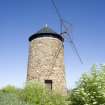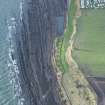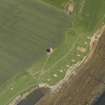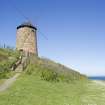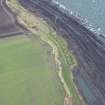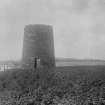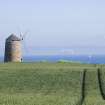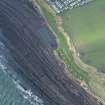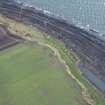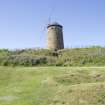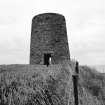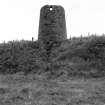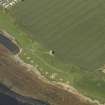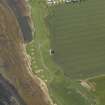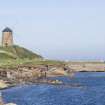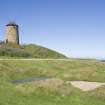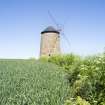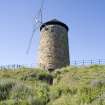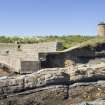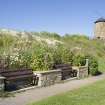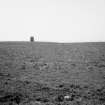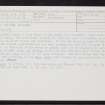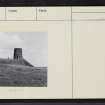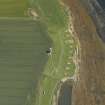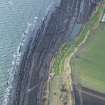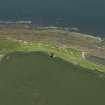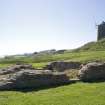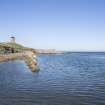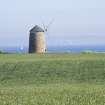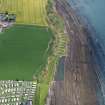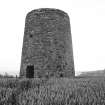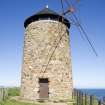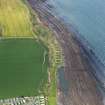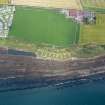Pricing Change
New pricing for orders of material from this site will come into place shortly. Charges for supply of digital images, digitisation on demand, prints and licensing will be altered.
Upcoming Maintenance
Please be advised that this website will undergo scheduled maintenance on the following dates:
Thursday, 9 January: 11:00 AM - 3:00 PM
Thursday, 23 January: 11:00 AM - 3:00 PM
Thursday, 30 January: 11:00 AM - 3:00 PM
During these times, some functionality such as image purchasing may be temporarily unavailable. We apologise for any inconvenience this may cause.
St Monance, East Braes, Windmill Tower
Windmill (18th Century)
Site Name St Monance, East Braes, Windmill Tower
Classification Windmill (18th Century)
Alternative Name(s) Coal Farm; Salt Works; St Monans; East Braes Saltpans; Wind Engine Tower; Firth Of Forth; Outer Forth Estuary
Canmore ID 34238
Site Number NO50SW 70.01
NGR NO 53308 01833
Datum OSGB36 - NGR
Permalink http://canmore.org.uk/site/34238
- Council Fife
- Parish St Monance
- Former Region Fife
- Former District North East Fife
- Former County Fife
NO50SW 70.01 53308 01833
Windmill [NR]
OS 1:10,000 map, 1994.
Formerly entered as NO50SW 48.
For associated salt pans and workings (on shore to SE, centred NO 5334 0180), see NO50SW 70.00.
Reference:
Cuttings
'Fife Leader': "Windmill set to attract tourists" - article and photographs
20 September 1993
'The Scotsman': photographs and caption
27 September 1993
(Undated) information in NMRS.
(Location cited as NO 534 019). Windmill tower, 18th century. Slightly tapered circular-section rubble tower of a windmill, originally used to pump sea water to salt pans.
J R Hume 1976.
On the raised beach at East Braes is the stump of a windmill, known locally as Windmill Tower. The structure, roughly 9m high and 4.5m in diameter on walls 1m thick, is built of rubble and sandstone. It has two doors in each of the E and W arcs. The wooden superstructure has been removed and the mill is open to the weather. In the base of the tower at ground level is an opening (1m square) which probably allowed axles and gearing to be led from the mill down to the rocks below where the salt pans (NO50SW 70) were situated. The mill dates from the late 18th century and according to the OSA (1793), was erected to pump water into the nearby salt pans.
I L Donnchie and N K Stewart 1967; G Douglas, M Oglethorpe and J R Hume 1984.
Excavation within the windmill tower uncovered a rectangular stone-lined pit housing a narrow timber beam set on sandstone flags. Iron staining on the flags probably indicated the position of the tower's vertical shaft.
Trial trenching to the S of the tower revealed part of another stone-lined pit on the slope of the raised beach and a similarly aligned rock-cut channel at the base of the incline. Although the mechanism is not fully understood, these channels are thought to have linked the tower to a pump that raised seawater from a tidal reservoir into the nine panhouses situated close to the sea shore. (See NO50SW 70 for salt pans.)
It is hoped that further excavation will fully expose these features and help in their interpretation.
Sponsors: East Neuk of Fife Preservation Society, Fife Regional Council.
J Lewis 1990b.
This windmill was used to pump up seawater into the saltpans NO50SW 70.00. It thus forms part of an early intergrated development which has not been obliterated by later works. Public information boards have been put in place.
P Martin 1992.
Scheduled (with NO50SW 70.01) as 'St Monans windmill and saltpans, 350m E of 45 MillerTerrace... the remains of a saltworks of 18th-century date, surviving as a complex of upstanding walls, earthworks and rock-cut features at 0-10m above sea level. The monument lies on gently sloping land extending onto the foreshore, 350m from the village of St Monans.'
Information from Historic Scotland, scheduling document dated 22 July 2011.
Project (2007)
This project was undertaken to input site information listed in 'Civil engineering heritage: Scotland - Lowlands and Borders' by R Paxton and J Shipway, 2007.
Publication Account (2007)
The saltworks was powered by the wind engine erected by landowner Sir John Anstruther and Robert Fall
in 1772–74 adjacent to the estate colliery where Coal Farm now stands. The tower, which is conical and about 27 ft high and 20 ft diameter at its base, formerly had sails, beneath which, in line with their shaft, were two reciprocating arms. The arms operated a pump which pumped sea water from the square pond on the foreshore, wooden pipes to a cistern supplying nine salterns containing the pans in which the water was boiled, using large quantities of coal, to produce salt. When in full operation it is thought that about 10 000 gallons of water would have been lifted about 16 ft from the pond. About 20 men were employed in the salterns, which were abandoned by 1823, probably because of difficulties in obtaining cheap coal, and only their foundations now remain.
A wagonway, disused from 1794, connected the saltworks and mine with Pittenweem Harbour. The tower, now conserved as part of a visitor centre on the Fife Coastal Path, was fitted in the mid-1990s with a conical tiled roof, which was raised to accommodate a glazed viewing gallery and four indicative dummy sails of frames of steel tubing.
R Paxton and J Shipway 2007
Reproduced from 'Civil Engineering heritage: Scotland - Lowlands and Borders' with kind permission from Thomas Telford Publishers.












































